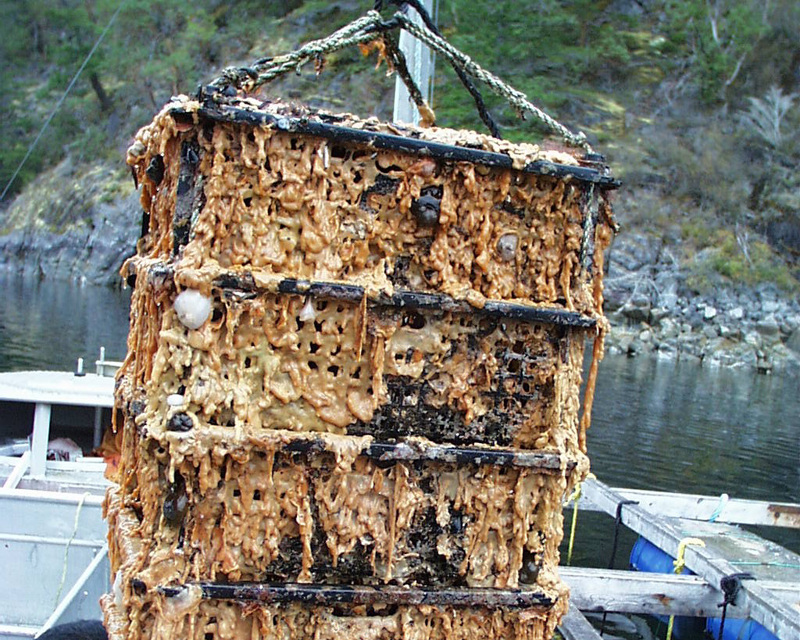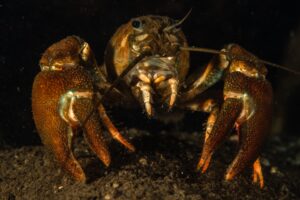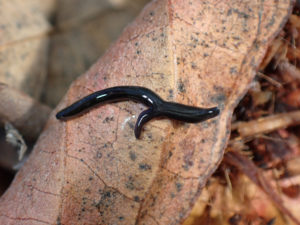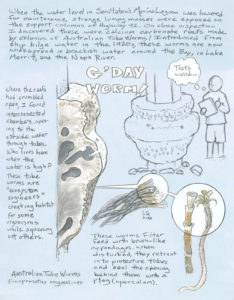A vile-looking invasive species is lurking around oyster beds in Point Reyes National Seashore, covering hard surfaces in slippery muck and prompting concern from environmentalists.
Colloquially dubbed “marine vomit” for its slimy, mucilaginous appearance, the marine invertebrate Didemnum vexillum, a sea squirt, is as ugly as it is fast-growing. While much about D. vex is not fully understood, morphologically similar species have been known to wreak havoc on aquaculture communities in other parts of the world, and could potentially harm marine life in places like Tomales Bay and Drakes Estero.
One thing that is crystal clear about villainous-sounding D. vex, however, is its ability to fuel the heated debate over the estero’s commercial oyster farm, whose lease is up for renewal. With U.S. Secretary of Interior Ken Salazar expected to announce a final decision on the lease this week, critics of the oyster farm have added the existence of D.vex to a litany of other environmental offenses, saying that the mere presence of the farm could facilitate an explosion of the species.
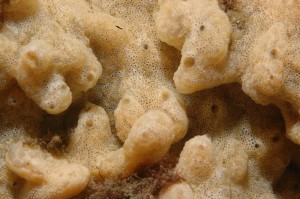
An ideal habitat
The soft, muddy bottom of the 2,500-acre estero doesn’t naturally provide ample solid surfaces where D. vex grows best, but the infrastructure of the Drakes Bay Oyster Company does. The hard substrate of wooden oyster racks, as well as boats, hulls, docks, pilings and the oysters themselves are the ideal habitat for the gelatinous goop, which is made up of thousands of sac-like creatures clustered underneath a membrane. More worrisome is the recent discovery of D.vex on the estero’s floor and on blades of eelgrass, a key plant that creates an important habitat here.
“I’ve seen it living on oyster racks, but when it was spotted on the sea floor, that was a huge alarm,” says Julia Stalker, a biologist who works on invasive species throughout the San Francisco Bay Area. “That means it can spread to the bottom and threaten the eelgrass population, which is one of the great resources of the estero.”
A 2010 study conducted by UC Davis Marine Biologist Ted Grosholz examined D.vex in Drakes Estero, comparing the colonies inhabiting the hard substrate provided by oyster racks with the surrounding habitats of rock and eelgrass. The observation of large colonies of D. vex growing on leaf shoots of native eelgrass was considered a significant finding.
Eelgrass is known as an ecosystem engineer. It pulls sediment out of the water, is a primary food source for many marine animals, provides shelter and serves as a nursery for species like herring to lay eggs. Some fear that D.vex will smother the eelgrass beds, ruining the safe haven and nutrients many organisms rely on, but Grosholz cautions that it’s too soon to tell.
“Introduced species continually pose a threat,” says Grosholz. “It’s really difficult to predict which ones will and which ones won’t, and this particular species remains very understudied.”
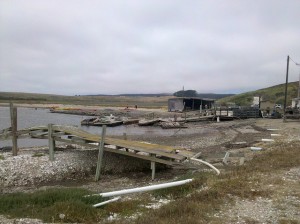
Getting rid of it
Currently, there is no major effort to eradicate D.vex in Drakes Estero, but the politically charged air surrounding the fate of the oyster farm has prompted some to demand that the National Park Service, which manages the habitat, quickly address the issue. Many environmental groups, including the Marin Audubon Society and the Environmental Action Committee of West Marin (EAC), have long called for an outright removal of the farm, which sits inside a designated wilderness area but was allowed to stay when the park was created decades ago.
In October, Stalker wrote a letter to NPS Director John Jarvis expressing “great concern” over the apparently expanding populations of D. vex. Also last month, EAC executive director Amy Trainer penned an opinion piece in the East Bay Express imploring U.S. Interior Secretary Ken Salazar to take a “good, long look” at the operations of the Drakes Bay Oyster Company. The existence of D. vex was among her concerns.
“We’re not trying to politicize the issue,” says Trainer. “But we’ve seen what this invasive species has done worldwide in the past five to 10 years, and it has the ability to devastate the entire benthic (bottom dwelling) community of the estero.”
The origins of D.vex are unknown, but some experts speculate that colonial sea squirts in the genus Didemnum could be native to Japan. It has been reported in North America since the late 1980s, when it was initially spotted in isolated areas on the East Coast. By the 1990s, it made its way to the West Coast, most likely by clinging t the hulls of boats and ships. It grows subtidally in bays, harbors, and coastal waters, on all types of artificial structures and on gravel and boulders.
A subtidal explosion
A 2007 study by a group of invasive species experts characterized D.vex as “currently undergoing a massive population explosion in subtidal communities on both coasts.” While it hasn’t shown to be anything more than a revolting blob in Drakes Estero and Tomales Bay so far, it’s crippled fisheries and natural areas in other communities, and experts say it has the potential to cause significant ecological and economic damage on both coasts.
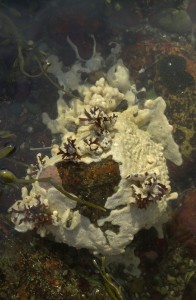
First reported in the San Francisco Bay in 1993, it wasn’t immediately known whether D.vex was native or not. It showed up around docks, harbors and other structures, growing out in sheets that would often fold over and fuse to other parts of themselves, forming irregular lobes that can take on a variety of colors and shapes – ropelike, bulbous, flat or branching out into considerable size, reaching up to a meter in length. It reproduces both sexually and asexually, and can create new colonies through fragmentation. Lobes can break off, drift away, and settle on a new surface to grow on.
“It wasn’t recognized as exotic at first,” says Andrew Cohen, director of the Biological Invasions Program at the San Francisco Estuary Institute and co-writer of the 2007 study. “There are so many invasive species in the San Francisco Bay, and a lot of them are so similar, we just didn’t know what we were looking at yet.”
The 2007 paper examined the basic biology and potential threat of D.vex to marine communities in North America. The paper found D.vex to be an effective invader for a number of reasons, most notably that it rapidly colonizes and has no natural predators. Where it blankets the sea floor, it could smother bivalves (which are important prey for fish and birds), reduce refuge areas on the seafloor, and overgrow sponges, macroalgae, anemones, and crustaceans.
Furthermore, all of the artificial surfaces in bays and harbors are helping it thrive, and possibly evolve. According to Cohen’s website, the transfers of shellfish stock or aquaculture equipment may play a role in coastwise spread, most likely along with transport as fouling on boat hulls.
“It can drift as adults on floating material – algae, Styrofoam, debris or buoys,” says Cohen. “Anything that humans move around.”
Cropping up
For a while, D.vex seemed to be retreating, but it was seen again in Sausalito in 2000, and began cropping up elsewhere around the Bay Area. It has since been reported in California from Humboldt Bay to Port San Luis. It hasn’t caused significant damage here yet, but other locales haven’t been so lucky. Several sites in Washington, British Columbia, and New England have experienced massive infestations that have posed serious impediments to mussel cultivation.
Additionally, it could have substantial impact on natural environments. On the northwest Atlantic coast, a colony of Didemnum infested a 100 square kilometer area, covering some areas of the bottom floor considerably and smothering organisms living there. In Drakes Estero, a simialr outbreak would destroy precious eelgrass beds.
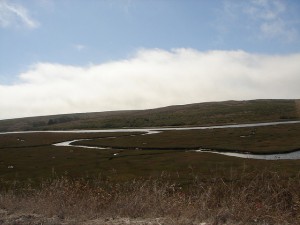
Grosholz emphasized that while the situation is definitely worth looking into, it’s impossible to predict the fate of Drakes Estero with regards to D. vex.
“Evolution does happen, and D.vex may evolve,” he says. “But we just don’t know.”
Still, the fear that Drakes Estero could end up like other areas affected by D. vex persists. In New Zealand, an attempt to eradicate an outbreak of D. vex was unsuccessful because it was undertaken after the species had become established.
“With invasive species, if you wait too long, it becomes too late to fix it,” says Stalker. “And if it isn’t too late, it can be too expensive. This isn’t an urbanized estuary that has all kinds of invasive species and pollution like San Francisco Bay. We have to keep it healthy.”
Heather Mack is a Bay Nature editorial intern.

